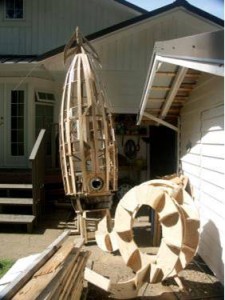 Guest post
Guest post
by Gordon Long
When I build special effects machines for movies, I usually start with an experimental model, often full size. Because I’m making something completely original, it’s a rather creative, make-it-up-as-you-go process, as opposed to the design-on-paper-then-build pattern that normal construction follows.
However, there comes a time in the process when the mockup is finished to a point, and I have worked out most of the mechanical bugs. Now I have to make the decision; do I keep on working with model, or do I start over from scratch? An impulse says, “I’ve already put a lot of hours into this one, it’s functioning well. Why not just keep going? Why go back to square one?”
Never Listen to That Little Voice.
 The 4-metre-tall mechanical squid in the picture went like that. It was a huge project, I had finished the working model, we were behind schedule and all sorts of good reasons like that, so we just went ahead and put the skin on the prototype (above).
The 4-metre-tall mechanical squid in the picture went like that. It was a huge project, I had finished the working model, we were behind schedule and all sorts of good reasons like that, so we just went ahead and put the skin on the prototype (above).
Now, the finished squid looked great and worked reasonably well. The film (“The Anachronism,” a steam-punk short drama) got all sorts of awards, including for Art Direction, but I knew that it wasn’t as good as it could have been. Deep underneath in the basic structure there were shortcuts I had taken and materials I had substituted, because I thought at the time that I was only making a trial model.
Book Formatting
I think you will see where this is going for the publishing process.
This summer I published a full-colour-with-pictures book. My client is doing an “In Memoriam” for a guy who started a ski hill and a community in northern British Columbia 40 years ago. So she called up 30 people who lived and skied at the hill, asking for their memories and pictures. She wanted it in National Geographic format: text, pictures, and captions all mixed together.
And here’s the problem. When she presented a completed rough draft of the project to me, I said, “This looks fine, but the first thing I’m going to do, I’m going to start from scratch with a text file, and go from there, re-format the whole thing. It will save hassles in the long run.”
She said, “That sounds expensive. I’m sure you won’t have to.”
I never should have listened to that little voice.
The basic problem is that I had no control over the format of the pictures. Because they were scanned and sent by multitudes of contributors, the editor had no control over them, either. So when I sent the finished MS to CreateSpace, their checking software rejected it because there are pictures that had not been flattened. They still had several layers, and the CreateSpace system can’t deal with layers. When you use .pdf files, they are very good about embedding fonts, photos, and layers. In this case, too good. The pictures should have all been .jpegs.
The question is, which pictures? There were about 150 of them, and I couldn’t find any way of figuring out which ones caused the problem. (I use MS Word, which I know isn’t the greatest program for this sort of work, but it’s what I’m used to.) CreateSpace has a free Adobe program called Pre-Flight which will do the job, but you have to pay for Adobe Acrobat first, and it looks like it doesn’t work on Macs anyway.
So finally, after much agony, I decided to start over. I made up a new blank file, transferred the Styles and started cutting and pasting the text and captions, copying each picture and pasting it into a new, flattened .jpg as I went.
It took me about 10 hours. Of course, I’d already spent longer than that messing with the old file trying to get it to work.
However, that version got accepted, the client is happy, and the shipment of books arrived (barely) in time for the memorial party.
I still wish I’d done it right the first time.
 Gordon A. Long is a writer, editor, publisher, playwright, director and teacher.
Learn more about Gordon and his writing from his blog and website.
Gordon A. Long is a writer, editor, publisher, playwright, director and teacher.
Learn more about Gordon and his writing from his blog and website.
Why Are People So Stupid? and the Sword Called Kitten Series are also available from Amazon and Smashwords, with book 2, The Cat with Many Claws available later this month.

Oh yes. Great advice. Trying to get people to start over from scratch is so hard even when it usually saves time. I feel your pain.
Yes, that little voice is a demon. 🙂 Sometimes starting from scratch is the only way to go. Great article, Gordon.
Great Advice, thanks!!
I thought you were going to give this advice, not for formatting, but for writing. As a writing coach I have had to deliver that message to my clients, that the structure of the novel/book/story is not working. Talk about hard. I feel like the dentist who says I can do this job for cheaper but if you want it to last a a lifetime, we need to do the big painful surgery. The hard way which often means going back to the beginning is tough but good. Not all the work disappears but it is a heartbreaking decision and after its made (to restructure) they are very very happy they did it. And, guess what? My coach made me do this recently with my screenplay. I have to write all my backstories in depth from scratch. It was tough news but I knew it was the right thing to do for the work to be the best.
Terrific advice, a post to bookmark and go back to regularly, if ever there was one. Thanks for reminding me not to cut corners. Ever. 🙂